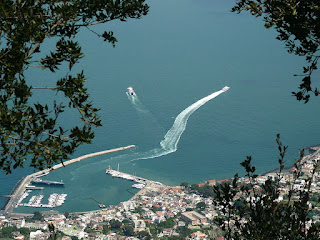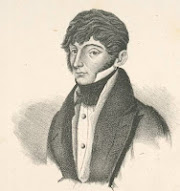The day calamity and chaos came to Casamicciola
 |
| The remains of a church in Casamicciola that was largely reduced to rubble by the quake |
Although the earthquake was officially classified as moderate, it caused extreme ground shaking, which led to the collapse of about 80 per cent of the buildings in the comune of Casamicciola Terme, a resort on the northern side of the island.
Most of the houses, hotels, and churches in the town collapsed. There were more than 1,700 fatalities in Casamicciola alone.
The philosopher Benedetto Croce was on holiday on the island at the time and both his parents and his only sister were killed in the earthquake. He was trapped under the rubble for two nights until he was able to be rescued, and it was discovered that he had a broken leg and arm.
His daughter later said that he suffered nightmares about his experience afterwards and that he never returned to Ischia.
But many people who were trapped under the wreckage of the buildings were not rescued and eventually died.
The earthquake occurred at 20.25 local time and had a moment magnitude of between 4.2 and 5.5. Though this was considered moderate, the ground shaking was judged to be extreme on the Modified Mercalli intensity scale. It is thought that between 2,313 and 3,100 people died as a result.
The island of Ischia lies within the circular area known as the Phlegraean Fields, a volcanic caldera consisting of 24 craters, most of which are submerged under the Bay of Naples.
_-_n._8180_-_Casamicciola_-_Piccola_Sentinella.png) |
| The Grand Hotel des Etrangers was one of the hotels that suffered catastrophic damage in the earthquake |
Since the middle of the 18th century, there have been records of earthquakes affecting the island.
In 1762, the architect Luigi Vanvitelli said he had experienced two successive shocks on the island, and in 1796, seven people died and 50 buildings were destroyed, after an earthquake.
In 1828, a violent tremor destroyed buildings in Casamicciola and at least 29 people died, including people who had been attending a church service. An earthquake in 1867 was experienced by the Norwegian playwright Henrik Ibsen, while he was staying there.
In March 1881, an earthquake caused 127 deaths and the collapse of about 300 buildings there. During the July 1883 quake, structures that had been damaged in 1881 but had not been repaired, collapsed completely.
In 1883, nearly half of the population of Casamicciola were killed and there were also deaths in Lacco Ameno, Forio, Barano d’Ischia, and Serrare Fontana.
Many Romans and Neapolitans were on holiday on the island at the time of the earthquake and a lot were attending a performance at the theatre. Large gaps appeared in the walls of the theatre and some theatregoers were able to escape through them.
People who were able to flee from the devastation made their way to the sea and were taken to Naples by boats to recover, and give an account of what had happened on the island.
 |
| Rodolfo Morgari's painting, Episode after 1883 earthquake at Casamicciola |
Newspapers came out in Rome with black mourning borders on July 30 to mark the event. The King and Queen of Italy - Umberto I and Queen Margherita - and the Pope, Leo XIII, donated money towards a national fund that was started for the relief of the earthquake victims.
As a result of the 1883 Ischia earthquake, the Italian government issued codes for antiseismic prevention
Even now, Italians will sometimes say: “Faccio una Casamicciola,” which literally means ‘I make a Casamicciola,’ when they are describing a state of calamity, chaos, and helplessness.
According to the American TV host and actor, Jimmy Kimmel, whose mother’s ancestors were from Ischia, only two of them survived the 1883 earthquake, later deciding to emigrate to the United States.
The artist Rodolfo Morgari depicted the aftermath of the 1883 earthquake in a painting entitled, Episode after 1883 earthquake at Casamicciola, which was exhibited in Turin in 1884.
 |
| The town and port, Ischia, seen from the top of the Castello Aragonese, which stands guard over the area |
Ischia is a beautiful island, just off the coasts of Sorrento and Naples, with many good beaches for holidaymakers. It has an area of some 47 square kilometres, rising to a height of 789 m (2,589 ft) at the peak of Monte Epomeo. The vineyards surrounding Monte Epomeo produce excellent wine that is served in the island’s restaurants. The hot mineral springs on the island have been used since Roman times as a cure for ailments and are still recommended for people suffering from rheumatism and arthritis today. An entire circuit of the island’s 34km (21 miles) of coastline on one of the local buses will take about two and a half hours. Ischia is also the name of the island’s main town, the other municipalities being Barano d'Ischia, Casamicciola Terme, Forio, Lacco Ameno and Serrara Fontana. Notable sights include the Aragonese Castle (Castello Aragonese), which was built on a rock near the island in 474 BC, by Hiero I of Syracuse. Nowadays, it is connected to the town of Ischia by a stone causeway.
 |
| A view across the harbour at Casamicciola, which stands on the northern coastline of Ischia |
Casamicciola is the oldest spa town on the island of Ischia and is thought to have once been the site of a Greek settlement. It is home to the hottest spring on the island, Terme Rita, which comes out of the ground at 180F and is said to contain large quantities of Iodine. One of the few hotels that remain standing from before the 1883 earthquake is Terme Manzi Hotel and Spa, which was founded in 1860. After the earthquake, the town was rebuilt and the Art Nouveau architecture lining the waterfront promenade dates from the early 20th century. The town continues to suffer sporadic earth movements linked to activity in the Phlegraean Fields caldera. As recently as August, 2017, it was hit by a 4.3 magnitude earthquake, resulting in the deaths of two people. Casamicciola has a pretty port and marina, which is often populated by expensive yachts. It is also an arrival and departure point for hydrofoils and ferries to and from Naples on the mainland.
Also on this day:
1883: The birth of industrialist Vittorio Valletta
1924: The birth of racing driver Luigi Musso
1941: The birth of conductor Riccardo Muti
1943: San Marino’s liberation from Fascism



.jpg)
.jpg)

.jpg)



.jpg)



.jpg)
